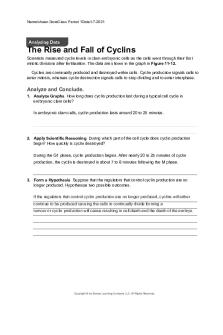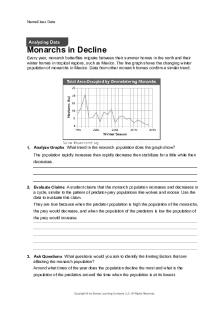D172 task2 - Assessment data are a key component in analyzing student progress and teacher PDF

| Title | D172 task2 - Assessment data are a key component in analyzing student progress and teacher |
|---|---|
| Course | Assessing Impact on Student Learning |
| Institution | Western Governors University |
| Pages | 4 |
| File Size | 73.1 KB |
| File Type | |
| Total Downloads | 85 |
| Total Views | 153 |
Summary
Assessment data are a key component in analyzing student progress and teacher effectiveness. As a teacher, you will be required to use assessment data to make evidence-based instructional decisions. In this task, you will analyze student data from the scenario, describe how you would provide student...
Description
KPM2 — KPM2 TASK 2: EVALUATING LEARNING AND INSTRUCTION ASSESSING STUDENT LEARNING — D172 PRFA — KPM2 A1.) With the information provided from the pre-assessment results, a strength is the Key/Signal word section. Only 5 of the 20 students got questions under the Key/Signal section wrong. Student 8 which is an English Learner, who needs background support and scaffolding for academic vocabulary, is the only student in the class that got both questions wrong in the Key/Signal word section of the test. Overall, the students did very well on this section of the test, scoring 85% proficiency. This data shows that the students were able to obtain the teachers goal of 70% accuracy on this section of the preassessment. It also shows that the students did well on recognizing key words.
A2.) A potential problem area on this preassessment was the Solution section. On average the students ranged from 15-50% proficiency in the solution section of the assessment, well below the teacher’s goal of 70% accuracy. There was 2 of the 20 students that got all four of the questions correct in the solution section of the assessment, and 17 students missed 2 or more question on this section. The data shows that this section was the section that the class struggled the most on.
B.) I would recommend the following adjustments to the Anticipatory Set portion of the lesson plan:
I would start the lesson with group instruction so I can introduce different types of questions. I would add practice questions that outlined the type of questions that the students will be completing in the constructed response section of the quiz as well as fill in the blank type of questions. Partner work to work and solve problems together with a peer.
Adding these adjustments into the lesson will allow students to better understand the type of questions that will be on the quiz and the type of responses I am looking for.
C1.) With the information provided from the Informal Formative Assessment, an area of strength is Key/Signal words section. Only three students are not proficient out of 20, so 85% of the students in this class are proficient in this section. Student 8,
which is an English learner is still struggling with this section, he was also a student that struggled in the preassessment. C2.) When analyzing the data, you see that a problem area for the students is the solution section of this assessment. Nine out of twenty students scored not proficient which is 45% of the students. Five of these nine students were general education students that have no learning accommodations that we know of. D. Whole Class – The students improved overall from the preassessment to the informal formative assessment. For the preassessment and the informal formative assessment the students scored an avg of 85% proficiency on both. On the problem section they improved from scores ranging from 25-60% correct to the class scoring at 75% of the students being proficient. 55% of the students showed proficiency on the Solution section of the test on the informal formative assessment and on the preassessment the students scores ranged from 15-40% of the questions correct. With this data you can see the students have improved and are starting to understand the lesson that is being taught. Student who demonstrated growth – Student number 18 demonstrated growth from the preassessment to the informal formative assessment. On the preassessment student number 18 scored an overall score of 50% which is the bottom of the scale form approaching proficiency. On the informal formative assessment this same student showed proficiency in all three section of the assessment, key/signal words, problems, and solutions. Student who did not demonstrate growth – A student that showed no growth and would be a concern to me is student 10. On the preassessment this student scored a 10% overall score on the three sections, which is not proficient, he also did not show proficiency in any of the three sections in the informal formative assessment. D1.) I would congratulate the class on a job well done on the key/signal word section of the assessment. I would also explain to them we still have some work to do on the problem and solution sections but that I believe in them and know that together we can conquer these sections as well. Student number 18 I would congratulate on a job well done and show them how much they improved from the preassessment to the informal formative assessment. I would also let them know how very proud I am of their continued hard work and desire to do their best. Student number 10 raises a lot of red flags to me, so I would discuss the assessment with them individually in a very non-threatening environment. I would go over the questions and reword them to verify the student is understanding the question and material. We would then come up with a study plan together as well as some manipulatives that may assist the student in learning the material better.
E1.) The area of strength on the formative assessment was the Key/Signal words section. Only two students did not score proficiency, but 18 students did score proficiency making 90% of the students are proficient on this section of the formative assessment. E2.) The solution section of the assessment is still a problem area for the students. Even though there was improvement from the preassessment the scores still ranged from 38-100% proficiency, with the average being 45% of the students being proficient in this area of the assessment. This data shows that there is still work to be done in this section of the assessment to meet proficiency in all areas. E3.) One possible reason for nonproficiency on the assessment could be the students needed more practice and discussion over the problem and solution sections of the assessment. With more practice the students could have built their confidence therefore their scores may have increased. Another possible reason for nonproficiency is the students not understanding what the problems were asking and the solution was to look like causing confusion in the students. F. Whole class- As a whole class the only scored a 15% proficiency on the preassessment, on the Summative assessment they scored a 85% proficiency. What an amazing improvement this class had! Student who showed growth – Student number 17, whom is an English Learner, showed amazing growth. On the preassessment this student scored a 20% proficiency which is not proficient and on the summative assessment they scored a 75% proficiency, which is proficient. Student who did not show growth – Even though Student 10 did have growth they are a student of concern because their growth still showed they were not proficient in this material. The preassessment score was a 10% and the formal assessment was 45%, both scores showing this student is not proficient. F1.) I would congratulate the class on a job well done they improved as a whole class a ton from the preassessment to the formative assessment. I would let them know they improved as a class by 70%! I would then go over a few problems the class struggled on as a whole, so that every student knows we can still improve and do better and that mistakes are ok and we all make them. For student number 17, I would congratulate them and commend them on all their hard work. I would let this student know their scored improved by 55%, and that all their hard work is paying off. I would also encourage them to continue to work hard and to do their best always. Student number 10 I would congratulate them for the improvement they made from the preassessment to the formative assessment. I would then ask if the study plan and manipulatives helped them in understanding of the material. I would also plan
one on one time with this student to continue working on the material to help with better understanding in the future. G. Presentation Procedures for New Information and/or modeling One adjustment I would make to the lesson plan under, Presentation Procedures for New Information and/or modeling is starting the discussion as a whole class assessing the knowledge the students already may have about problems and solutions for language arts. I would then demonstrate some constructive response answers, demonstrating this to the students will help them better understand what I am looking for in the answers on the assessment. Guided Practice: Another adjustment I would make to the lesson plan under, Guided Practice, is while they are working with their partners have the students work together solving questions like the questions that will be on the assessment in the problem and solution sections of the assessment. More practice will benefit the students and in turn their scores will improve. G1.) My recommendations in part G would provide for more practice for the students on problems that will be on the assessment. Providing more practice on problems that will be like that on the assessment, will help improve students scores as they will have been provided more opportunities to work on problems and solve them in different ways to prepare them further to succeed on the formative assessment....
Similar Free PDFs

Steps in Analyzing a Poem
- 1 Pages

Cpccohs 2001 A -student assessment
- 10 Pages

BIO CH13 Analyzing Data
- 1 Pages

BIO CH11 Analyzing Data
- 1 Pages

Task2 - mar
- 2 Pages

Progress-report-A
- 5 Pages
Popular Institutions
- Tinajero National High School - Annex
- Politeknik Caltex Riau
- Yokohama City University
- SGT University
- University of Al-Qadisiyah
- Divine Word College of Vigan
- Techniek College Rotterdam
- Universidade de Santiago
- Universiti Teknologi MARA Cawangan Johor Kampus Pasir Gudang
- Poltekkes Kemenkes Yogyakarta
- Baguio City National High School
- Colegio san marcos
- preparatoria uno
- Centro de Bachillerato Tecnológico Industrial y de Servicios No. 107
- Dalian Maritime University
- Quang Trung Secondary School
- Colegio Tecnológico en Informática
- Corporación Regional de Educación Superior
- Grupo CEDVA
- Dar Al Uloom University
- Centro de Estudios Preuniversitarios de la Universidad Nacional de Ingeniería
- 上智大学
- Aakash International School, Nuna Majara
- San Felipe Neri Catholic School
- Kang Chiao International School - New Taipei City
- Misamis Occidental National High School
- Institución Educativa Escuela Normal Juan Ladrilleros
- Kolehiyo ng Pantukan
- Batanes State College
- Instituto Continental
- Sekolah Menengah Kejuruan Kesehatan Kaltara (Tarakan)
- Colegio de La Inmaculada Concepcion - Cebu









